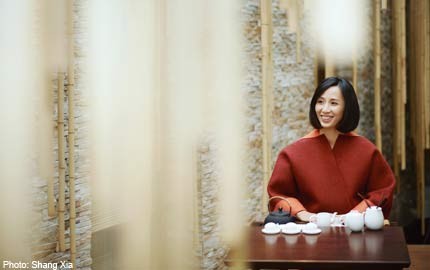Changing the 'Made In China' perception

CHINA - Rare Zitan wood chairs that take more than six months to craft and run into the six figures, and cashmere felt wrap jackets that take artisans over a week to sculpt without stitching are just some of the signature items produced by Chinese luxury label Shang Xia.
The brand, launched as a joint venture between French designer label Hermes and Shang Xia's artistic director and chief executive Jiang Qiong Er in 2008, is a unique experiment characterised by a commitment to Chinese craftsmanship.
The name Shang Xia means "up and down" in Chinese and nods to juxtapositions such as East and West, past and future. It works with about 30 artisans in China to create modern lifestyle products.
Furniture, clothing, homeware and jewellery are all painstakingly handcrafted to offer goods inspired by Chinese heritage, such as eggshell porcelain teacups and chairs inlaid with bamboo marquetry.
Ms Jiang, who is married to a French entrepreneur and has two children, says that the brand's relationship with the artisans helps to preserve skills that may have been lost with them.
"It's important to show families that these skills can be used to create in new functional ways," says the 37-year-old. For example, an eggshell porcelain master's daughter had left the family business to work in Beijing, but returned after she saw there was still a demand for such work.
Shanghai-based Ms Jiang, who speaks English with a hint of a French accent, was in town to speak at the International New York Times' luxury conference last week. She wears a layered sleeveless black dress from Shang Xia during the interview with Urban. The material of the dress looks like leather but is actually lacquered silk, she says proudly.
Ms Jiang herself is uniquely positioned to lead the brand. Immersed in China's art world, her grandfather, Jiang Xuan Yi, was a noted painter and her father, Xing Tong He, was an architect who designed the Shanghai Museum.
From a young age, Ms Jiang studied with painter Cheng Shi Fa and calligrapher Han Tian Hong before getting her degree in art and design from Shanghai's Tong Ji University. Later, she studied furniture and interior design at Paris' Decorative Arts School.
After graduating, she worked as an artist as well as the creative director of Hermes windows in China. An encounter with outgoing Hermes chief executive Patrick Thomas led to a conversation where they talked about topics important to them - of quality and craftsmanship.
Her work as an artist, which showcased elements from the East and West, had made her more aware of Chinese craftsmanship and design. That, combined with her background in both the Chinese and French art worlds, made her a logical choice to lead the project.
Ms Jiang describes the brand as being born out of a long-held desire.
"I always had this dream to combine Chinese cultural inspiration and traditional craftsmanship with contemporary design so that the essence of our culture and the best craft can live on," she says.
She describes Hermes - with its culture of quality, materials and craftsmanship - as the father of Shang Xia and herself as the mother. The French brand is also the majority stakeholder.
"Chinese culture and beauty are the essence and inspiration of all Shang Xia collections," she says, stressing the brand's independent operations. Hermes leaves all decisions, from what products to create to which artisans the brand works with, to Ms Jiang.
The prices of Shang Xia products, like Hermes', are on the high end. Hand-painted poker cards sell for about 50 euros (S$85), while porcelain tea sets can cost 3,900 euros (S$6,638).
The brand has three boutiques in Shanghai, Beijing and Paris. The French store, on Rue de Sevres next to an Hermes boutique, opened in September. About 80per cent of customers in each store, including the one in Paris, is local, she notes. It reflects a global appreciation of quality products and bodes well for the brand's future overseas, she says.
One of the most rewarding experiences from launching the Shang Xia brand has been the emotional reaction of Chinese customers discovering the brand and its quality products, Ms Jiang says.
"Customers will come in and say 'I'm proud to be Chinese again'," she says, adding that some even shed tears.
While challenges exist - in terms of how to develop the brand's presence and stores consistently, and making sure artisans grow along with the atelier - Ms Jiang says feedback has been surprisingly positive. She sums up, with a serene smile: "The 'Made in China' perception is changing."
llim@sph.com.sg

Get a copy of Urban, The Straits Times or go to straitstimes.com for more stories.